Learning how to show don’t tell in writing is one of the most difficult—and important—parts of writing when you first start. Even if you claim to be experienced. But the online world of advice in this department is still more confusing than it is helpful.
Many giving advice about showing vs telling don’t often fully understand the concept themselves. So the advice come across vague, and the examples leave much to be deciphered.
But when you start writing a book, it’s as if everyone around you becomes the expert. They tell you to show don’t tell, start with action, or even embellish your stories to sound “better.”
But how do you know what advice to take…and what do those writing tips even mean in the first place?
We’ll help you understand the idea of “show don’t tell” in ways that are actually applicable.
Because there are times when telling matters.
Understanding the nuances of when to show vs tell is a huge part of the process.
Here’s what you’ll learn about show don’t tell in writing:
- Understand what show don’t tell means
- Learn from examples of showing versus telling
- Cut the “sensing” words to show don’t tell
- Avoid emotional explaining when showing not telling
- Describe body language
- Use strong verbs to show don’t tell
- Focus on describing senses
- Practice showing not telling every day
What does show don’t tell mean?
Show don’t tell is the process of writing to create a strong visual in the minds of the reader that will allow them to interpret what’s happening, rather than telling a reader what happened.
By showing the actions and relationships and feelings instead of just telling the reader what happened, the writing comes off deeper, and more meaningful. This creates a much deeper connection and brings readers closer to you (or the main character).
This is a quick example of the show don’t tell rule:
TELLING: Candice was anxious about how late she was.
SHOWING: Candice’s eyes flashed to her phone. 9:33. She picked up her pace so it matched that of her heart, scampering down the hall. She had yet to climb two floors before reaching class. Again, her eyes flashed to the clock. 9:35. Couldn’t time slow down? Just for one morning!
You can think of it like this: telling is the simple explanation of what is otherwise shown without using the same words.
If a person were to ask you what is happening in the shown example, you would reply: “Candice was anxious about being late.”
That is how to show don’t tell.
Describe what is happening in any way other than using the interpretation of what is really going on. This creates an experience for the reader. One in which they both feel the emotions taking place, and also gives the reader the opportunity to use their own deduction to understand the story. This use of inference is a main reason readers read. They don’t just want to be entertained, they want to use their minds.
By using the “show don’t tell” rule in writing, you’re giving readers that satisfaction.
Show Don’t Tell Examples:
These examples are pretty basic but that’s the best way to gain an understanding of what this looks like. Keep in mind that your sentences may be more complex than these examples, but still full of “tell” words or phrases.
Be on the lookout for the details, and focus on reading books to decipher how that author uses the show don’t tell rule.
Show Don’t Tell Example for Narrative & Prose
EXAMPLE 1:
Tell: It was eerily quiet on the road until the sound of footsteps terrified me.
Show: Crunching hit my ears from behind, accelerating the already rampant pounding of my heart.
Why this showing example is better:
In an instance such as this, you want the reader to feel what you did: the surprise and the sense of urgency, the fear.
Describing the crunching that hit your ears even through the pounding of your heart not only creates a powerful visual, but it also tells the reader the state your body was in during that intense moment. The first example is weak and does little to explain how you actually felt in that moment.
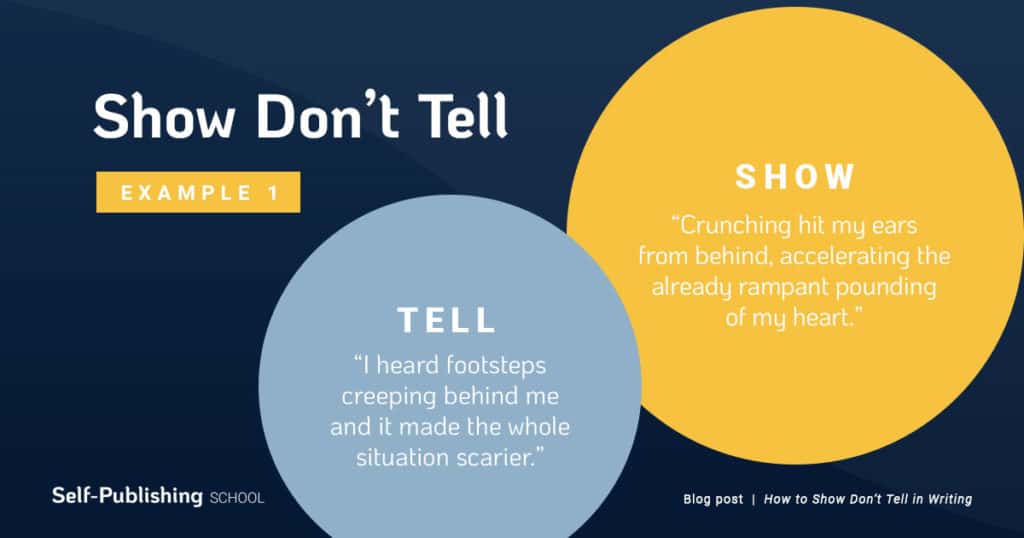
EXAMPLE 2:
Tell: “She was my best friend. I could tell her almost anything.”
Show: “I met her at the town square, running in for our usual hug that carried on for far too long as we gushed about our lives with smiles lighting our faces.”
Why this showing example is better:
The first example of telling is shorter, but it doesn’t do a great job of really showing the impact you have on each other. Anyone can think of “best friend” and form an overall thought about what that looks like. But this isn’t just “anyone.” This is your best friend. Showing your relationship with one another is vital to forging that deeper connection.
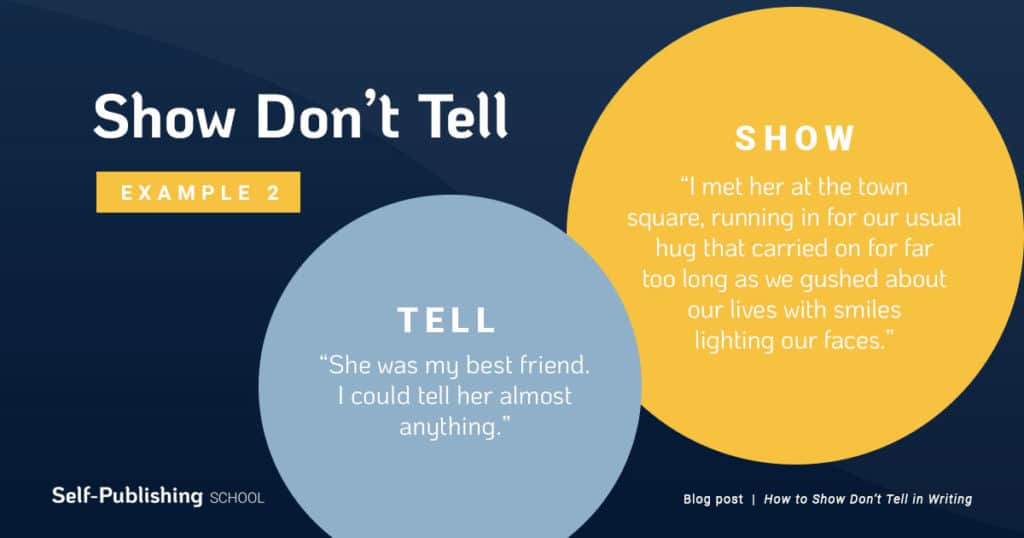
EXAMPLE 3:
Tell: The sound of his voice shocked the students.
Show: The students jolted as one, immediate silence followed as heads whipped in the direction of the voice.
Why this showing example is better: It’s not significant, but it’s a more vivid way of showing what’s happened. The way you’d show a shocked group of students could be many ways. Here, fear is what we see by using “jolted” and the depicted visual. That can do a lot to fill in the gaps of the relationship the teacher has to the students as well. Show don’t tell is a great way to fill in those gaps.
Show Don’t Tell Example for Dialogue
Writing dialogue is tricky because we almost never say exactly what we mean. In fact, it’s difficult to plainly state how we feel, what we want, and more. But the way we say something does a lot to show what’s going on with us inside.
But we don’t often see many rules for how to show don’t tell with dialogue. That’s why I’ll break it down in a few examples.
EXAMPLE 1:
Tell: “What do you think of my project?” she asked nervously.
Show: “Oh, I don’t know,” she said. “The top is a little funky, and the bottom,” she trailed her fingers down its side, “turned out wider than I planned. But I think I got most of it. Of course,” her hands rolled over one another, “it took longer than I thought it would and…well, here it is!”
Why this showing example is better: Many people, especially those insecure or nervous, won’t directly ask someone what they think about something. Especially if they’re not a forthcoming person. But as you can see here, the showing version of this dialogue allows the reader to understand that she’s nervous, and is probably seeking the other person to comment on what she created. Plus, this gives cadence to how she speaks, which further helps develop character.
EXAMPLE 2:
Tell: “I think that was a stupid decision,” he huffed.
Show: “What were you thinking?” his voice was low and clipped. “Do you have a death wish? Do you want us all to die? Was there even a single thought running through your head at all?”
Why this showing example is better: The baffled nature of several questions does more to explain how this character feels than a single sentence. Now, some characters might just come out and say it. But if you want to employ show don’t tell rules and allow the readers to pick up on what this character is like, this example of showing does that. You don’t need him to say he thinks it was a stupid decision. His line of inquiry does that for you.
EXAMPLE 3:
Tell: “I’ve fallen in love with you.”
Show: “It’s always obvious when you’ve spent time in the sun,” he tucked a strand of hair behind her ear. “Not by the quiet peace you seem to embody on those days, nor the slight smile that lingers on newly reddened lips, but by the freckles.” He paused, holding a hand to her face, just an inch from her cheek. “Ever so darker than they were just the day before, blooming across your nose and cheeks like your favorite flowers do the meadow in the dawn of spring.”
Why this showing example is better: Being able to show don’t tell when it comes to love is very subjective, but always carries something potent. Specifics do a great job. To know someone or a quality of theirs so deeply, and to be communicated with romance, is a simple way of showing his love for her through dialogue. He doesn’t need to say that he’s fallen in love with her in order for her—and the reader—to feel it.
Show Don’t Tell Examples in Whole Scenes
You can show in an entire scene or paragraph, through a construction of the plot, instead of just single lines, which is typically what you see in examples online for the show don’t tell rule.
The truth is much of good books include entire scenes or chapters that leave the readers reeling and contemplating about what just happened. Not in a confusing way. In a way that leaves the reader with an impression of both the plot and characters at the same time.
Brandon Sanderson is an author who does this really well. It’s as if some of his books and entire chapters embody the show don’t tell rule. Specifically, his Way of Kings novels with the interludes included.
This example is very simple and a brief way of showing what you can expand into entire scenes to show don’t tell. The idea is to try your best not to outright say what his happening in the scene, but instead have the characters behave in a way that it’s clear what’s going on.
Almost like pretending there’s someone watching the scene, and the characters are doing their best to hide what’s truly happening from that viewer.
EXAMPLE 1:
Tell: She couldn’t believe how much he’d grown.
Show:
“That’s not fair!” He shouted.
His nose was wrinkled in the same way it used to when he had trouble counting pebbles for his lessons as a boy. The same nose, set on the same face, with the same eyes not quite as wide. Not quite as innocent.
He used to glare at those pebbles the way he now glared at her.
Why this showing example is better: It’s not much, but by highlighting what hasn’t changed, we understand that this character is actually thinking about the past. She’s comparing, and almost longing for a time when he was just a boy, counting pebbles. If this scene were to expand, we’d likely see more shown about how the events are crafted around the boy wanting to feel more adult, and the viewpoint character holding him back.
Why should you show don’t tell in writing?
The entire point of using the show don’t tell rule in writing is to make a stronger emotional connection with your readers and hook them.
They already picked up your book for the killer title and eye-grabbing cover, but they need a reason to stay. The idea behind this writing technique is to put the reader in the characters’ shoes. Make them feel, hear, and sense the situation as they do.
It’s about creating an experience for the reader instead of just a recount of events.
Doing this makes the reader want to root for the character. They want to hear your whole story and in turn, they’ll read your whole book.
Why is showing not telling also important for non-fiction?
If you write fiction, you hear this advice all the time. However, all of you non-fiction writers out there, this piece of writing advice might be new to you.
Show don’t tell isn’t always the first thing a non-fiction writer thinks of when it comes to adding more intrigue to your story.
But it is the most vital for pulling your reader in and not only hooking them, but keeping them with you throughout the duration of your book.
Many fiction writers hear this writing advice often because it’s one of the best ways to make real people feel deeply for fictional characters.
When it comes to writing a story about your life and something you went through, the idea is the same. By showing and not telling, you’ll be able to guide them through your real-life situation as an experience and not just some book they’re reading while the kids are yelling at their video games and the oven alarm is blaring in the distance.
If you can show don’t tell the right way, the reader won’t even notice those distractions.
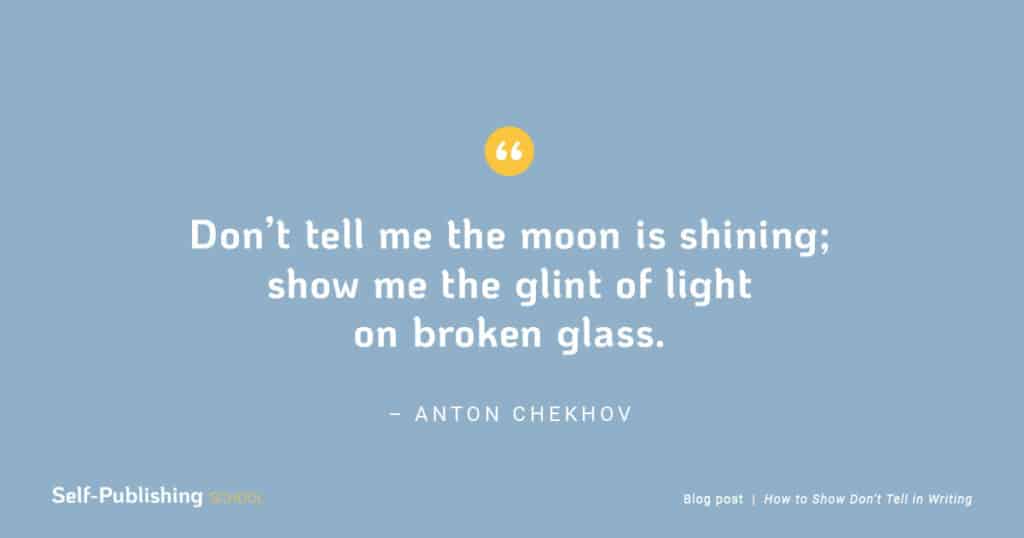
How Often Should You Show VS Tell
It depends on your stylistic choice and natural voice as an author. But you do want to show more than you tell.
Whether or not you end up describing things in immense detail depends on what you like. If you want to describe the crumble of a statue in a lot of detail, do so! Especially if the statue is important to the plot of your story. You can easily hide types of foreshadowing during these cases of showing.
A good show don’t tell rule is to show what’s important to the character and the plot, and tell between the gaps.
You don’t always need to describe what makes a person look angry. You can even have your main character use a line like, “Well, she’s angry again.” within the narrative. The purpose here would be to skip to the reasons behind the anger, which would be shown through dialogue (examples above).
The point is to figure out what works for you. Get feedback from beta readers, and determine how often you should show don’t tell depending on your own taste.
It’s your art!
How to Show Don’t Tell in Writing by Editing
So now you know what it is and why it’s important, but how the heck do you actually do it? The process of taking a single story and crafting it to create more emotion can be difficult.
Thankfully, we have some of the best tips for showing not telling in writing.
1. Cut basic sensory words
Phrases like, “I heard,” “I felt,” and “I smelled,” are all very weak. These are “telling” words and phrases (also commonly referred to as “filters”) that force the reader further away from you and your experience.
That’s exactly what you want to avoid.
Instead, you need to pull them into your world and into your psyche the very moment you were encountering the situation.
This is done by using strong verbs and other visual language. Click here to find a list of strong verbs.
Show Don’t Tell Exercise #1:
Step 1: Read through your writing and circle every telling word you can find. Anything that explains one of the 5 senses.
Step 2: Then write down specifics for each. If you heard someone creeping up behind you, how did you hear it? Was it crunching on gravel? Was it the shuffling of shoes against carpet?
Once you have these, rewrite those sections by explaining how the senses manifested to you and not just what you sensed (detailed below in the next writing exercise).
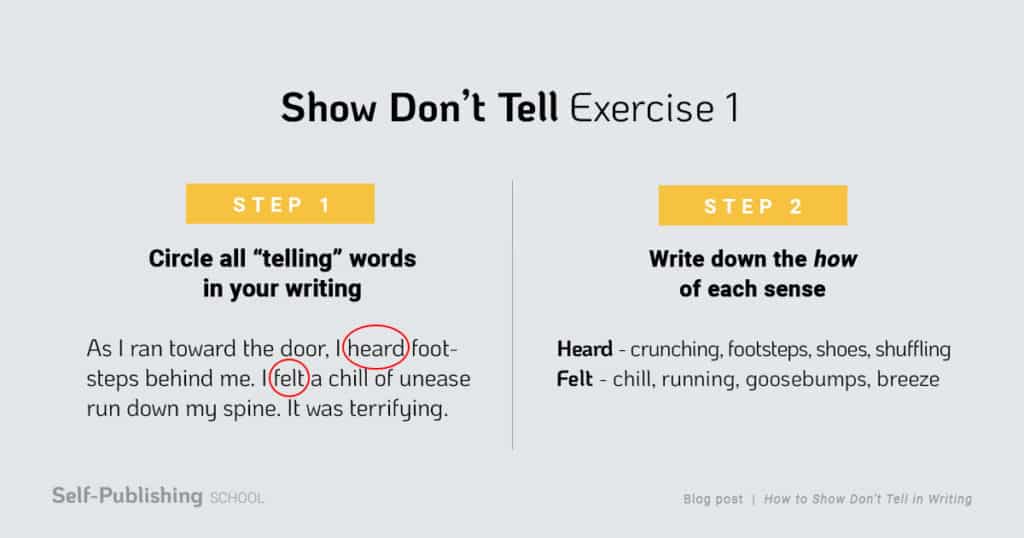
2. Cut “emotion explaining” words
This might be a bit tricky and you certainly don’t have to follow this one 100% of the time, but if you can get this right, it’ll make showing versus telling so much easier to grasp.
Think of any word to describe an emotion. I’ll help you out a little:
- Happy
- Sad
- Angry
- Frustrated
- Excited
- Giddy
- Love
- Anxious
- Joy
- Disgust
I could go on, but I think you get the idea.
These are all great words to describe how someone felt. However, they’re also very weak, unexciting ways to do so. If you need your readers to understand how excited you were at any given time, show them. Don’t just tell them, “I was so excited!”
Show them the sweat beading your forehead as you raced to your destination. Show them the lifting of your cheeks as your lips parted way for an uncontrollable smile.
Show Don’t Tell Exercise #2:
Skim through your writing and circle every word that’s an emotion.
Then, for every emotion-explaining word you find, write down physical reactions of feeling that way.
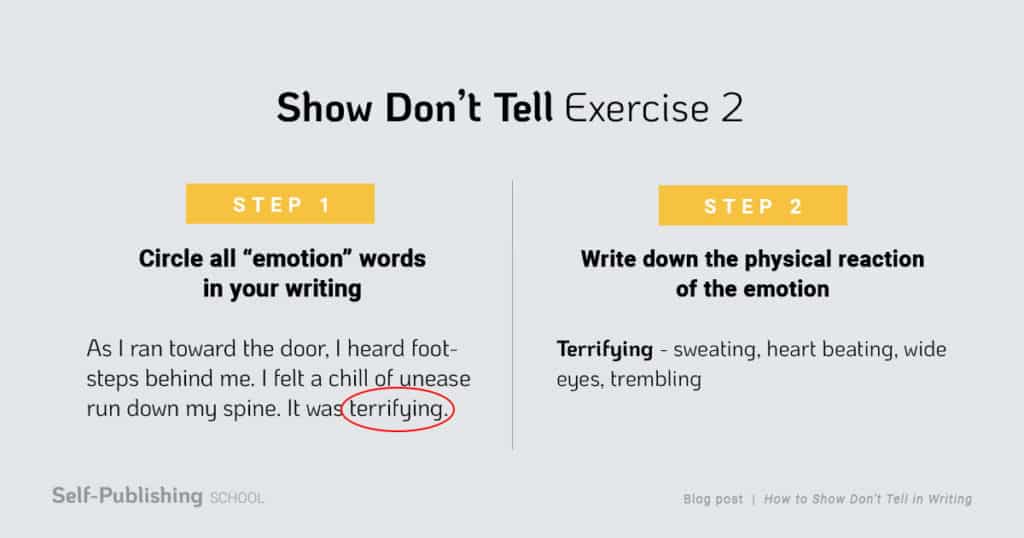
Once you have a small list for each circled word, use it to craft a couple of sentences to describe (and show!) just what that looked like.
You can see the difference alone between these two paragraphs. By replacing all of the “telling” words and phrases, it develops into an experience for the reader and not just a retelling of what happened.
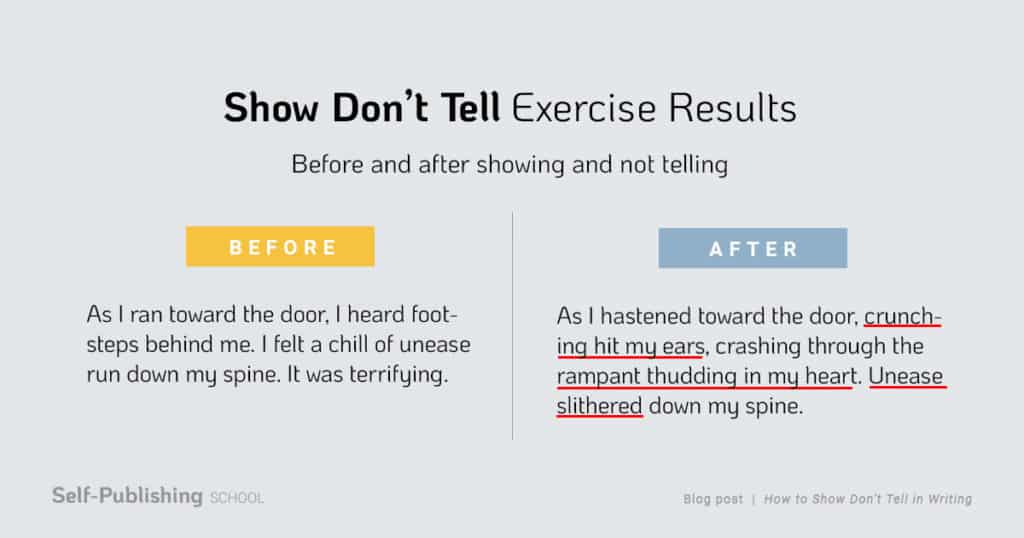
3. Describe body language
One of the best ways you can show not tell in writing is to use strong descriptive language when it comes to body language.
A person’s actions are really a gateway to their mind and how they feel.
You can tell if another person has a crush on someone just by paying attention to the way their body adjusts when in that person’s presence, right? Learn how to do research for your novel, whether on social interactions, setting, or otherwise.
Showing versus telling in writing is exactly that. You want to show the reader what is happening and allow them to form a conclusion about how you or others in your story felt based on what they look like.
In all honesty, a lot of this one is about having faith that your audience can put two and two together.
Oftentimes, we tend to over-explain in an effort to make something obvious when really, the emotion is in the guesswork; it’s in allowing someone to draw their own conclusions. That over-explaining is what comes across as “telly” and not as emotionally compelling.
And honestly? It’s also pretty boring and flat.
If you do a great job of showing what you want readers to see, they’ll understand how someone feels – and they’ll even feel that way themselves.
That’s the power of showing not telling.
4. Use strong verbs
Showing itself can be extremely impactful, but using strong language and verbs in specific situations is even more powerful for adding depth to your story.
The way you make someone else actually feel how you did as you were going through the experience is to make sure the words you’re using directly reflect the emotions.
This can be a difficult task for those who aren’t sure what “strong language” looks likes, but I’ll make it easier for you.
Show Don’t Tell Exercise #3:
Think of a situation you want to explain in your book (or maybe something you already have written out).
Now imagine what feeling you want to convey through that scene. What do you want your readers to take away from that specific moment in your story? List those emotions so you can see all of them.
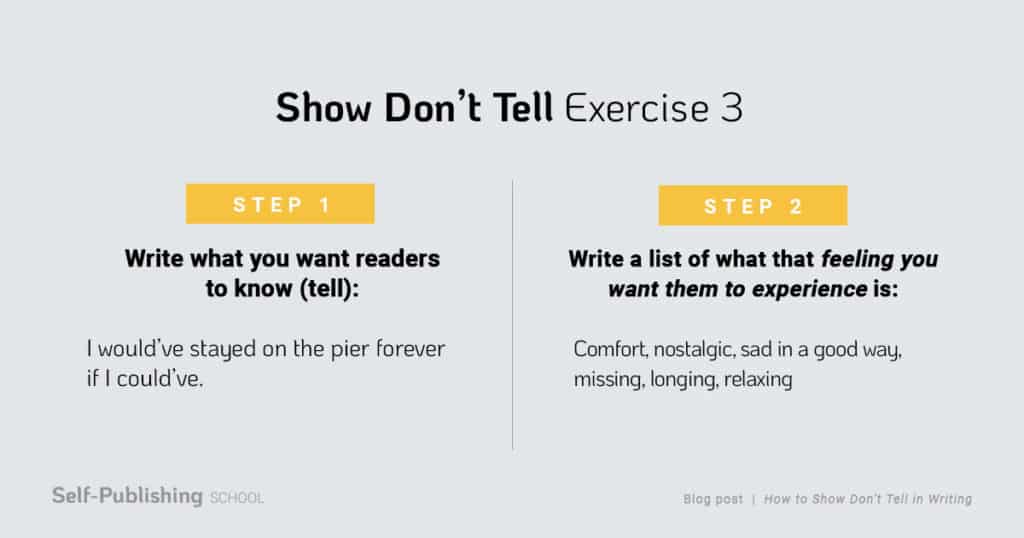
Take that list and start writing ways in which you can bring those emotions to life. What do those things mean for you? How would these emotions manifest during that specific time?
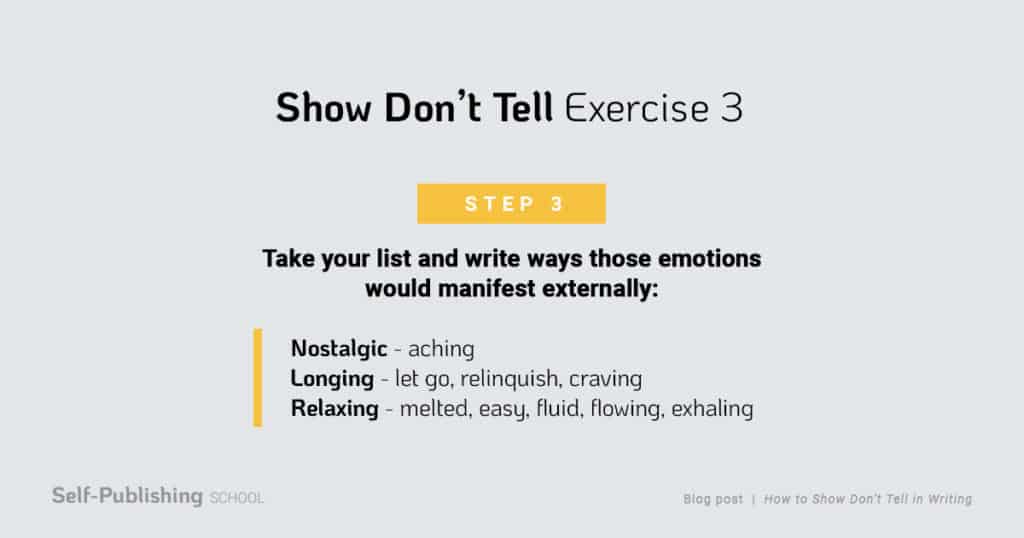
Now take those stronger verbs and words that depict a deeper emotion and craft your sentence or paragraph with those to reflect how you truly felt.
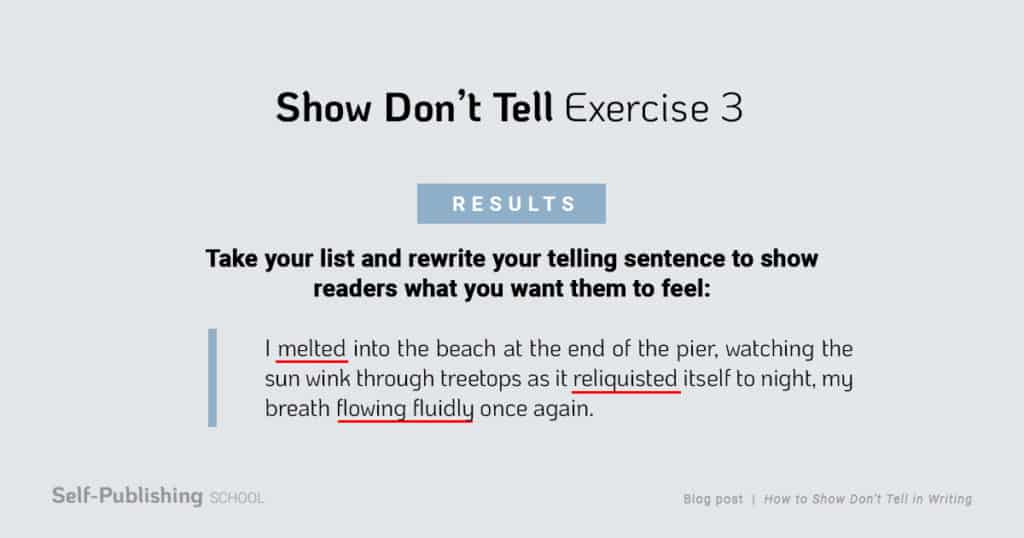
How does this sentence make you feel? Do you feel comfort, relaxation, and a sense that I love being there?
That was the purpose.
It’s about taking one specific idea or vibe or feeling and using what you know to transform it into something that’s showing not telling.
This specific example for show don’t tell can be a little time-consuming at first, but you will get the hang of it and these methods will soon become second nature to you.
5. Focus on describing senses
We told you to cut sensing words in tip #1, and that’s true, but with this comes the fact that you still have to describe what your character is feeling and sensing.
Showing versus telling is largely about allowing your readers to interpret what your characters are going through without just telling them.
This often means using all the senses you can to depict a scene.
Instead of saying, “She hated it there.” you can use her senses to show the readers that emotion.
For example: writing with showing like this “The faint scent of stale cigarette smoke met her nostrils, pulling her face into a familiar grimace.” allows your readers to understand that she finds where she is distasteful, without having to just say so.
6. Practice showing not telling every day
To master the tip of show don’t tell in writing, it takes time and practice to get it right. There’s a fine line of using showing versus telling in your writing.
With regular practice (by writing every day, we suggest), you’ll learn when to use telling and when to use showing in order to give the reader the best reading experience they have.
You can even practice by reading other books and your own writing. Recognizing areas of showing can help you do it more in your own works.


Book Outline Generator
Choose your Fiction or Nonfiction book type below to get your free chapter by chapter outline!
Book Outline Generator
Enter your details below and get your pre-formatted outline in your inbox and start writing today!
CONGRATULATIONS
Thanks for submitting! Check your email for your book outline template.
In the meantime, check out our Book Outline Challenge.
